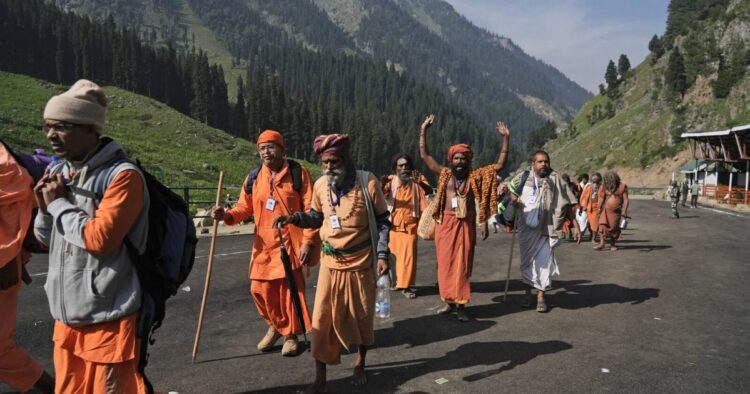This year’s Amarnath pilgrimage in the south Kashmir Himalayas concluded with more than 5.10 lakh pilgrims offering prayers at the sacred cave shrine. The successful and safe completion of the annual yatra was made possible by the dedicated efforts of more than a dozen Mountain Rescue Teams (MRTs) that assisted thousands of pilgrims throughout the journey.
The MRTs were composed of personnel from the Jammu and Kashmir Police, State Disaster Response Force (SDRF), National Disaster Response Force (NDRF), and the Central Reserve Police Force (CRPF). These teams were flagged off by Additional Director General of Police Vijay Kumar and deployed along the twin tracks leading to the 3,880-metre-high cave shrine about a week before the 52-day pilgrimage began on June 29.
Eight MRTs were stationed along the 48-kilometre traditional Pahalgam route in Anantnag district, while five teams were positioned on the shorter but steeper 14-kilometre Baltal route in Ganderbal district. According to Inspector Ram Singh, the MRT in-charge, the teams were in place by June 24, just before the pilgrimage began, after conducting two back-to-back reconnaissance missions along the routes.
Inspector Singh, who made history by becoming the first personnel from the Jammu and Kashmir Police to scale Mount Everest in May 2008, shared that the MRTs played a crucial role in rescuing over 1,300 pilgrims who were in dire need of help. In addition, they provided oxygen to around 20,000 pilgrims suffering from altitude sickness and distributed more than 20,000 raincoats free of cost to the devotees.
The MRTs also extended their assistance to local service providers and security personnel who faced challenges due to the harsh weather and high-altitude conditions. The rescue teams bravely navigated the snowbound, treacherous tracks to ensure the safety of everyone involved in the pilgrimage.
The pilgrimage concluded with the arrival of the Chhari Mubarak, the silver-robed mace of Lord Shiva, at the cave shrine on Monday afternoon, coinciding with the festival of Raksha Bandhan and the occasion of Shravan Purnima.
Singh, who is scheduled to return to the base camp in Srinagar after the Chhari Mubarak’s return from the cave in the next few days, explained that each MRT team operated in a specific area, covering the entire yatra track, including key locations such as Sheshnag, Mahagunas Top, Poshpatri, Dardkote, Sangam Top, Brarimarg, and Railpathri.
Each member of the MRTs was equipped with an individual kit containing gaiters, overmitts, mountain rescue equipment like carabiners, jumars, descending rappels, avalanche rods, helmets, oxygen cylinders, first-aid kits, and communication tools. These supplies were essential for handling the various emergencies that arose during the yatra.
An SDRF spokesperson highlighted the invaluable role played by the MRTs during the yatra, describing it as a journey of faith that tested both physical endurance and spiritual resolve. The spokesperson noted that the efforts of the SDRF and other MRTs were instrumental in ensuring the safety of the pilgrims, resulting in minimal casualties and widespread appreciation from the pilgrims and authorities alike.
The MRTs’ dedication was evident in their willingness to carry unconscious or severely ill pilgrims on their backs or stretchers, navigating the steep and rocky paths with great care. This proactive approach led to a significant reduction in serious incidents and fatalities during the yatra.
A video shared by the SDRF captured the gratitude of the pilgrims, who expressed their appreciation for the crucial role of the MRTs. One woman pilgrim thanked the MRTs, saying, “They were very helpful. Special thanks to them for their help, otherwise, it was not possible for me.” Another pilgrim remarked, “There was no tension when the SDRF teams were around. For us, they are a form of our Lord.”
ALSO READ: “Jammu & Kashmir: Indian Army Captain Martyred In Encounter With Terrorists In Doda”
The spokesperson emphasized that the exemplary work of the MRTs had not gone unnoticed. Their presence not only provided physical assistance but also a sense of security and reassurance to the yatris. The efforts of the MRTs have been widely recognized and appreciated by the pilgrims, the broader community, and the authorities.
The SDRF’s first battalion control room and joint police control in Pahalgam played a crucial role in effective coordination, ensuring that this year’s yatra was one of the safest in recent memory, with minimal casualties.
The MRTs’ tireless efforts, advanced training, and seamless coordination made this year’s Amarnath yatra a safe and successful experience for the thousands of pilgrims who participated.















Comments